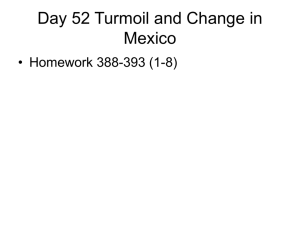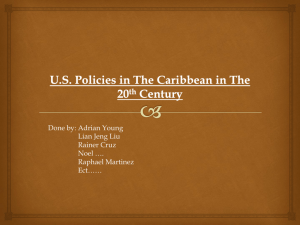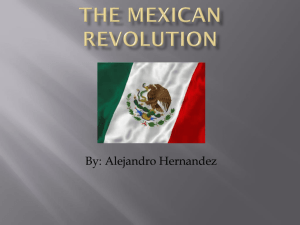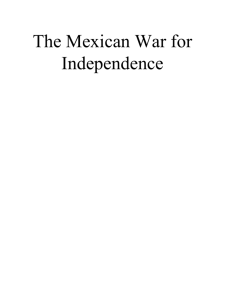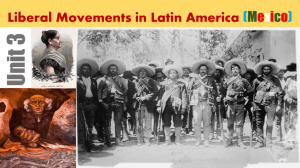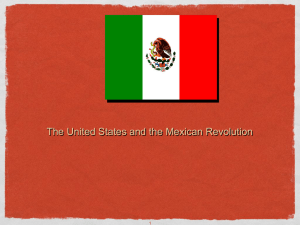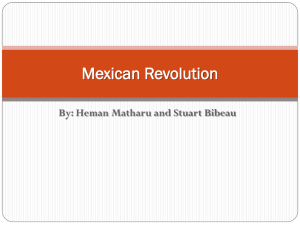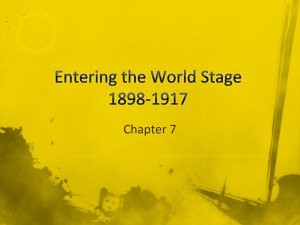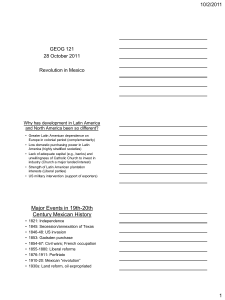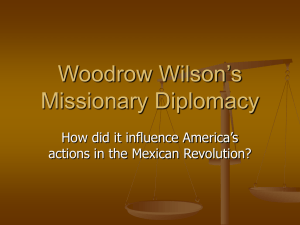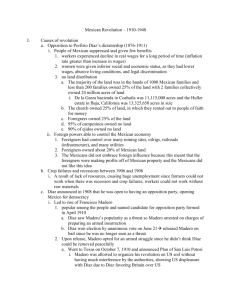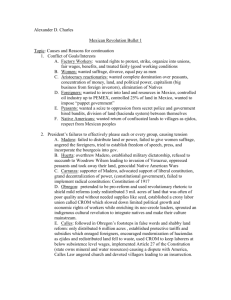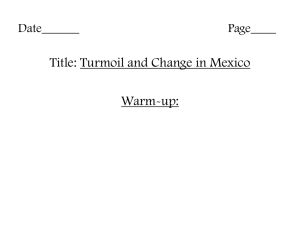File - ChapmanHistory.org
advertisement
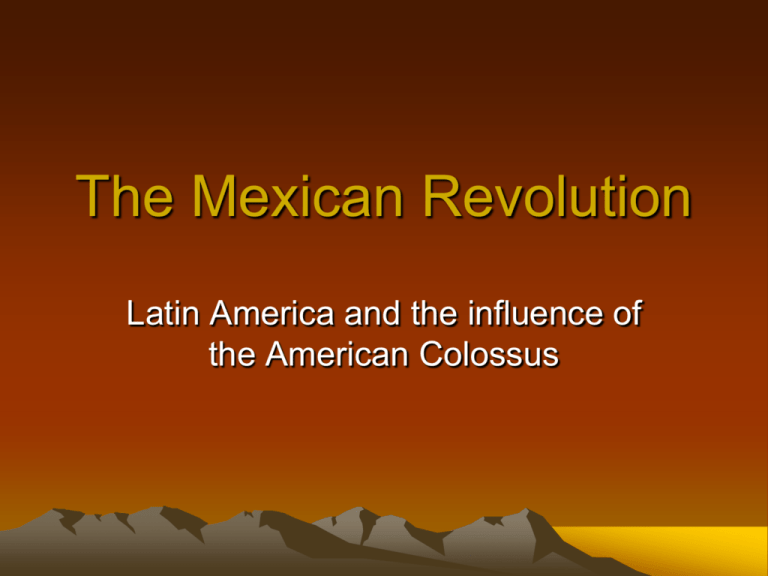
The Mexican Revolution Latin America and the influence of the American Colossus Neocolonialism in Latin America • Neocolonialism = dependence upon Britain & later U.S. instead of Spain or Portugal • Growing trade with Europe helped stabilize political climate of L. Am. • More stability in L. Am = more foreign investment – L. Am exchanged raw mats. and food for finished goods from Europe and N. Am – Led to abandonment of native factory capitalism – Integrated into international economic system Limited Progress for L. Am • L. Am countries locked into export of a few primary items (coffee, sugar, etc.) • Vulnerable to fluctuations in international markets • Domestic capitalism unlikely w/out sweeping reforms in land and labor policies – Would be painful for ruling elites so they chose easier road of dependency upon GB or US Land Policy as a Cause of the Mexican Revolution Land and Labor • Indigenous lands typically seized to expand haciendas • Local labor force fell into debt peonage – Scrip, company stores, inheritable debt, forced labor to pay debts • Poor work conditions, long hours, unions outlawed and strikes brutally broken • Caused a range of resentments among indigenous and agricultural population Latin America 1900-1930 • Recurrent imperialist interventions by U.S. • International competition for favored access to L. Am markets – Strategic raw mats., cheap labor, investments • Market forces eroded family – more women working – as well as rural isolation – Migrants streamed to urban slums and foreign lands seeking employment • Fed flames of 1910 Rev. in Mexico • WW I did inspire some industrialism due to necessity Increasing American Control • U.S. investment in L. Am 2nd only to GB by 1914 • Economic intervention = political influence • Armed intervention and “Dollar Diplomacy” – Cuba, Dominican Rep., Nicaragua & others become dependencies or protectorates of U.S. • Mexican exports increasingly geared to needs of U.S. – U.S.- and GB-controlled oil 3rd among world oil producers – “Mexico, mother of foreigners and stepmother of Mexicans” The Porfiriato in Mexico • Gen. Porfirio Diaz seizes pwr in Mex. 1876 • Won pwr w/ support of broad coalition – Incl. regional caudillos, liberals, indigenous and mestizo small landholders, and U.S. capitalists and large TX landholders who viewed predecessor as anti-American • Diaz ruled for more than 31 years – era known as the Porfiriato – One of longest personal dictatorships in L. Am history • Eventually relied on wealthy Mexicans and foreign capitalists to ensure his position Porfirio Diaz • President of Mexico – 1876-1880 – 1884-1911 Protecting the Porfiriato • Opponents beaten, murdered, imprisoned • Rurales – mounted police who suppressed peasant unrest and broke strikes • Army enjoyed special privileges but officers chosen because of loyalty, not skill • Land laws passed to concentrate land ownership among Mexican elites – Deprived indigenous and small landholders of land • A major problem – weakening economy raised cost of living and anger for mass of population Growing Discontent • Labor strikes and agrarian unrest continued despite repression • Professionals & intellectuals who hoped for social advancement or reforms • Upper-class liberal reformers – Francisco Madero (landowner and businessman) – Upper-class feared continued repression would cause masses to revolt and overthrow capitalism in MX. • Social and economic problems by 1910 had eroded support for the Diaz regime Francisco Madero starts Rev of 1910 • Believed in democracy by elite in name of people – Similar to early U.S. leaders • Critical of Diaz’s social policies – Thought they would lead to massive unrest • Limited reforms for workers and peasants would head off radicalism Madero • Madero planned overthrow of Diaz from U.S. – Suggests U.S. displeasure with Diaz – Taft hoped for better attitude by Mex. toward U.S. • Upon return to Mex., 2 major rebel leaders emerged – Pancho Villa led peasant revolt in northern border region – Emiliano Zapata led indigenous revolt in agricultural southern Mex. – Both pledged loyalty to Madero over Diaz • An urban labor revolt also undermined Diaz Compromise leads Diaz to resign • May 21, 1911 – Diaz resigns, leaving his ambassador to the U.S. as interim prez – Porfiristas saw move as a way to calm things down until they could reconsolidate their control – Continuing hostilities with Zapata by Porfiristas continues the revolutionary wave. • Madero wins presidency in Oct. 1911 – the “Apostle of Democracy” – Really only provides the illusion of democracy – Some changes for workers but Madero abandon’s real land reforms A break with Zapata undermines Madero • One-time ally Zapata breaks from Madero and issues Plan of Ayala on 11/28.1911 – Lands taken from peasants and indigenous population would be returned to original owners – Zapatista movement spreads throughout central and southern Mexico • Now Madero lacked support of elites and poor – Madero used military to fight Zapata & others throughout 1912 – Gen. Victoriano Huerta defeated revolts but further alienated a large segment of Mexican population – Madero’s main allies now the military – Also lost the support of the U.S. U.S. intervention – Part One • Feb. 1912 – U.S. troops stationed at border – U.S. Ambassador threatens intervention if U.S. interests and lives not protected • While secretly plotting with Gen. Huerta, the U.S. warned Madero of U.S. action • U.S. encouraged Huerta to arrest Madero & others in govt. and do “what was best for (Mexico)” • Madero murdered in jail – Huerta becomes new prez to the approval of landed elite, capitalists and the church Huerta vs. the Revolutionaries • Villa and Zapata renewed their struggles with landed elites – Huerta’s armies tied down fighting rebels • Villa a “Robin Hood” – type character who took revenues of northern estates and used $ to help poor • Zapata took lands away from large landholders and redistributed it to peasants • Venustiano Carranza emerged in 1913 to call for the overthrow of the dictator Huerta Venustiano Carranza • Large landowner who called for constitutional govt. – Joined by Villa • Woodrow Wilson refused to recognize Huerta’s regime – claimed it came to power illegally – Also convinced that Huerta couldn’t provide political stability – Feared Euros might gain better access to Mex markets • WW I shifted Euro interests to winning support from the U.S. – abandoned financial support of Huerta Mexican Revolutionaries Francisco Madero The “Apostle of Democracy” Pancho Villa – “Robin Hood” for the northern peasant class along the border. Venustiano Carranza The Constitutionalist Emiliano Zapata Champion of the landless and poor of southern and central Mexico U.S. Intervention - Part Two • Wilson used the arrest of U.S. sailors in Tampico to justify sending a fleet to Mex. • U.S. troops occupied Veracruz to prevent German Arms shipment to the Huerta govt. – Set off wave of anti-U.S. sentiment in Mexico and other L. Am countries – Including Carranza (Wilson’s hope for stable Mex.) • Wilson disapproved of Zapata & Villa and tried to negotiate the removal of Huerta – supported the presidency of Carranza • Carranza spurned Wilson’s “help” and Huerta fled to Europe • No more Huerta meant no reason for U.S. troops – They left Veracruz on Nov. 23, 1914 Constitutionalist alliance fails • As interim leader - Carranza vague on his position on agrarian reforms – Villa and Zapata supported Zapata’s Plan of Ayala for land reform – Carranza refused to accept Plan, leading Villa & Zapata to occupy Mex. City • Carranza forced to promise often conflicting policies to varying groups to prolong influence – Skillfully drove wedge between workers and peasants – divide and conquer – Armed conflict resumes • Carranza forces defeat Villa and Zapata by end of 1915 U.S. Intervention – Part Three • Oct. 1915 – Wilson recognizes Carranza regime but continues efforts to interfere – Embargoes arms to Carranza opponents • Angry with U.S. – Villa raids Columbus, NM • Wilson sends Gen. Pershing to pursue Villa – Wrongly assumes Carranza would approve • Carranza demands U.S. withdrawal and rallies support of other L. Am countries against U.S. aggression • Failure to capture Villa and concern of major war with Mex. leads to U.S. withdrawal Constitution of 1917 • Progressive constitution hammered out by representatives at 1916 convention • Included far-reaching protections of labor and small landholders • Protected private property, placed controls on foreign biz, supported growth of natl. capitalism • Carranza the first legally elected president of Mex. since Madero • Once prez, he fails to implement many reforms • Other than standing up to U.S. and remaining neutral in WW I, Carranza ignores his pledges The fall of Carranza • Zapata murdered by Carrancistas in 1919 – Struggle for “tierra y libertad” continued w/out Zapata • When Carranza tried to extend his power beyond his legal term – former supporter Alvaro Obregon turned on him – Carranza was killed after fleeing Mex. City in May 1920 • Obregon assumed presidency in Nov. 1920 – Revolution over – Mexican population declined by 1 million 1910-1920 (dead, missing, emigrated)
